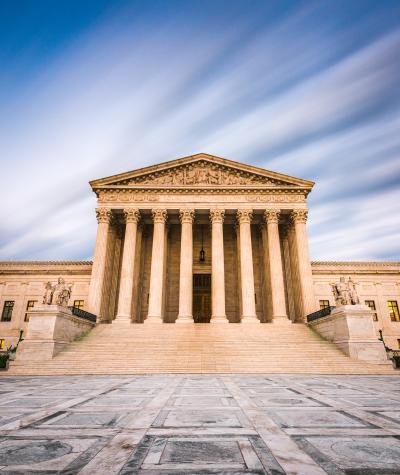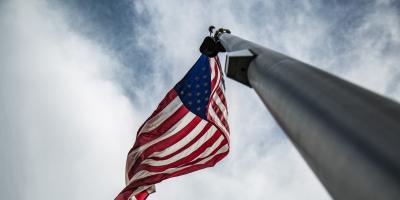The U.S. Supreme Court is once again facing a crucial decision: whether to preserve or upend important legal precedents governing how our elections are financed.
The National Republican Senatorial Committee (NRSC) has brought a challenge to longstanding limits on how much money political parties can spend in “coordination” with federal candidates.
The Supreme Court upheld these coordinated spending limits in 2001 in a decision known as Colorado II. There, the Court determined that these limits were an important barrier preventing donors from funneling massive amounts of funds to the candidates of their choosing through political parties.
Limitations like these are key in preventing wealthy special interests from leveraging deep pocketbooks to manipulate our elections and drown out the voices of everyday Americans.
It's time for the Supreme Court to again sustain these limits. Campaign Legal Center (CLC), joined by the League of Women Voters and Common Cause, filed an amicus brief urging the Court to follow its own precedents and reaffirm the constitutionality of this important anti-corruption law.
Political Parties Are a Conduit for Big Money
For our democracy to be effective, candidates and elected officials have to answer to their constituents — not wealthy special interests.
Campaign contribution limits play an important role in reducing the influence of wealthy donors on our politics and guarding against the political corruption that may come hand in hand with multi-figure donations. These limits help ensure that our officeholders are accountable to all citizens.
A key principle of campaign finance law, reinforced by the Supreme Court, is that an expenditure that is “coordinated” with a candidate is functionally the same as a contribution given directly to the candidate.
Otherwise put, there is not much difference between directly contributing $1,000 to a candidate and “coordinating” with the candidate about how you spend that $1,000 for their benefit, for instance, by buying $1,000 worth of election ads at the candidate’s direction.
These coordinated spending limits ensure that donors cannot bypass the limits on how much they can give directly to a candidate by rerouting a much larger amount to the candidate via contributions to that candidate’s party. For instance, in 2024, a donor could give only $3,300 to a candidate directly per election, but $41,300 annually to the candidate’s party.
For over 50 years, these limits on party coordinated spending have served as an important anticorruption tool, ensuring that party committees do not serve as a mechanism for wealthy donors to circumvent individual contribution limits and direct large contributions to candidates.
The Landslide Effect of Rolling Back Campaign Finance Laws
The NRSC is arguing that both the legal landscape and real-world campaign practices have changed, making the Supreme Court’s reasoning in its 2001 decision in Colorado II no longer legally sound.
But the opposite is true: Recent campaign finance developments make laws like the party coordinated spending limits more important than ever. Wherever the Court has chosen to roll back legal restrictions on big money in campaigns, an explosion of money in our elections has followed.
When the Court struck down the limits on corporate expenditures to influence elections in Citizens United V. FEC, the Justices reasoned that unlimited corporate spending wouldn’t corrupt our elections because of disclosure laws.
Fifteen years later, wealthy special interests have successfully flooded our elections with "dark money” from sources that are often never disclosed to voters.
When the Court ruled against aggregate contribution limits in McCutcheon V. FEC, the majority argued that it was too speculative to assume that any donor would seek to support a single candidate by cutting a six-figure check to a “joint fundraising committee” (JFC) — an entity that “joins” the candidate’s campaign committee with multiple party committees to boost its fundraising potential.
Since 2016, however, we’ve seen JFCs raise millions of dollars for individual candidates, while the Federal Election Commission (FEC) simultaneously makes it easier still for these groups to influence elections.
Over and over again, when the Court chips away at federal campaign finance laws, the integrity and fairness of our elections suffer. Each time, the Court’s decisions have resulted in more money flooding into campaigns and less accountability and disclosure. The Supreme Court must reinforce what it has previously established to be true: Contribution limits are at the heart of keeping elections fair.
Rethinking Campaign Finance Reform
The current patchwork state of our campaign finance system, coupled with an FEC that has abandoned its mission to enforce the law, has let the wealthiest Americans play an outsized role in our elections and governance.
When candidates for elected office rely on big money to win elections, the American people have little guarantee they will prioritize the public good if elected.
It is clear that even if the Supreme Court upholds these long-standing protections against unlimited coordinated spending by political parties, a more holistic overhaul of our campaign finance system is urgently needed. And that’s exactly what Campaign Legal Center has been fighting for since our founding more than two decades ago.
Support us today as we advocate for stronger, better enforced campaign finance laws that keep our government working for the people.



